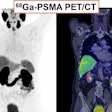Dear AuntMinnie Member,
Annual compensation for radiologists edged up in 2016, to an annual median salary of $490,399. Although up only 1.4% compared with 2015, the level represents a third consecutive year of salary growth for radiologists after a two-year slump from 2011-2013.
The figures come from the annual survey of physician compensation by the American Medical Group Association. The survey found that cardiothoracic surgeons were among the highest-paid physicians, with a median compensation close to $650,000, while other specialties like family and internal medicine occupied lower rungs of the salary spectrum, with median compensation levels below $250,000.
Do the numbers represent a rebound for radiologists? Or are they "smoke and mirrors" that mask a still-weak jobs market, as one AuntMinnie member suggested in our Forums? Decide for yourself by clicking here.
New VR tools coming
Radiologists may soon have access to new tools based on virtual reality (VR) technology for interpreting cases, planning surgeries, and other clinical applications. Advanced visualization developer EchoPixel announced today that it plans to begin shipping a version of its True 3D platform that marries the company's unique software with a workstation and display from computer giant HP.
EchoPixel has been making the rounds at medical conferences for the past several years, eliciting wows from users impressed by the ability to seemingly extract pieces from virtual images and manipulate them in midair. The software is also being tested by Dr. Judy Yee at the University of California, San Francisco for its application in CT colonography.
But can True 3D move from being a cool toy at trade shows to an indispensible tool for clinicians? Only time will tell, but until then read about the technology by clicking here, for an article in our Advanced Visualization Community at av.auntminnie.com.
Questions about thyroid imaging
The use of medical imaging to diagnose thyroid imaging has been questioned by some who believe that scans are uncovering many cases of disease that would never pose a health threat to patients. Now, a new study is questioning whether follow-up imaging after treatment for thyroid cancer really helps improve patient survival.
Researchers from the University of Michigan looked at recurrence rates for thyroid cancer over a 13-year period, finding increased use of imaging but no improvement in survival rates -- with the exception of one type of imaging procedure. Find out which one by clicking here, or visit our Ultrasound Community at ultrasound.auntminnie.com.



















